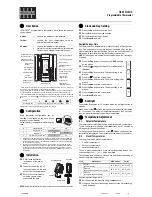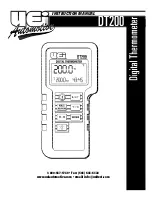
T7200D,E, T7300D,E,F AND Q7300 SERIES 2000 PROGRAMMABLE COMMERCIAL THERMOSTATS AND SUBBASES
63-4355—1
23
Interfacing with
Electromechanical Economizers
(Subbases with Auxiliary Relay)
Mechanical cooling is often used when outside
temperatures are in the 50
°
to 60
°
F range and humidity is
below 50 percent. In central and northern climates,
hundreds of hours fall into this temperature category. By
permitting 80 to 100 percent outside air into the system,
mechanical cooling may not be needed at all, particularly
during Spring and Fall.
An economizer is used to take advantage of the outside air.
The typical economizer consists of an outside air damper,
motor, outdoor air changeover control and a minimum
position potentiometer. The motor controls the dampers.
Suitability of the outside air for cooling is determined by the
outdoor air changeover control. The potentiometer is used for
adjusting the minimum position of the economizer dampers,
which provide a minimum amount of fresh air for ventilation.
The economizer reduces compressor run time, thereby saving
energy and extending the compressor life. The drawback to
using the economizer is that during the Unoccupied period, if
there is no call for cooling or outdoor air is not suitable for free
cooling, the economizer is controlled to minimum position. This
position allows some percentage of outdoor air to enter the
building, regardless of air suitability. The situation can cause
the heating or cooling to run more often than if suitable outdoor
air is permitted to enter the building.
The thermostat can take advantage of an economizer by
connecting the auxiliary relay contacts (A1 and A2) of the
subbase to control the economizer minimum position
potentiometer. The contacts close during the Occupied
period, allowing the economizer to operate normally. The
contacts are open during the Unoccupied period, disabling
the minimum position feature of the economizer. The open
contacts cause the economizer to drive dampers fully closed
instead of staying at minimum open position. This reduces the
possibility of unsuitable outdoor air from entering the building,
which lowers the internal load on the HVAC system and saves
additional energy.
Fig. 18. Use of external relay and transformer for auxiliary
loads greater than 1.6A.
TROUBLESHOOTING GUIDE
Refer to Table 14 for troubleshooting information.
M4944
L1
(HOT)
L2
1
1
2
2
POWER SUPPLY. PROVIDE DISCONNECT MEANS AND OVERLOAD
PROTECTION AS REQUIRED.
RELAY REQUIRED (R8222 OR SIMILAR).
Q7300 SUBBASE
TO
LOAD
AUXILIARY
RELAY
CONTACTS
A1
A2
A3
Other Uses for the Auxiliary Relay
Examples of other uses of the auxiliary relay are hot water
heaters, lighting or baseboard heat. The additional loads are
connected to the auxiliary relay contacts on the subbase. The
contacts are rated for 1.6A at 30 Vac, but can be adapted to
higher current applications with the use of an external relay
and transformer. See Fig. 18.
















































